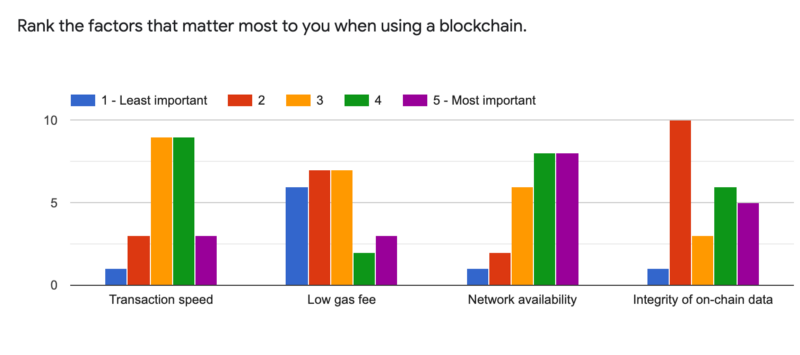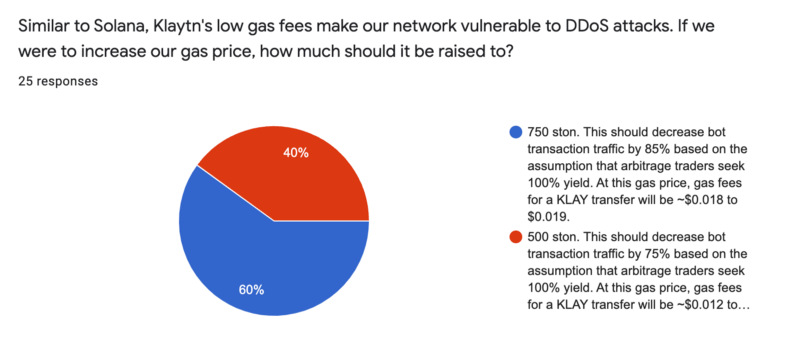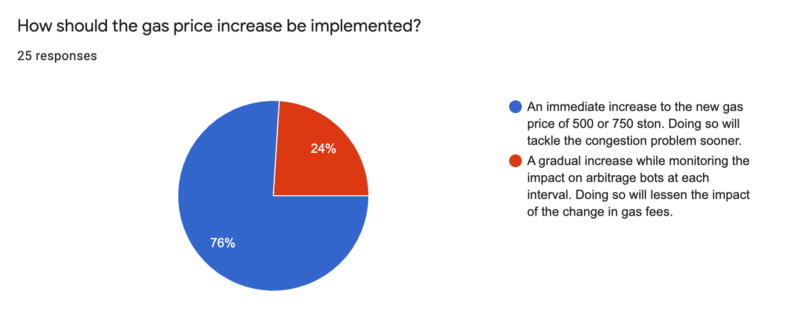Recap of Gas Price Increase AMA with EZ and Colin
We had the pleasure of hosting EZ Yi, our Head of Strategy, and Colin Kim, Klaytn Core Development Team Leader, for an informative AMA session where they answered the community’s questions about Klaytn’s plans to increase the gas price to combat arbitrage bots. Listen to the AMA session below or read on for our recap!
Note: Some of the text have been edited for grammar and clarity.
Date & Time: Feb 18th at 1pm SGT / 2pm KST
Platform: Twitter Spaces
Speakers: EZ Yi and Colin Kim from Klaytn Foundation
Host: Sofy, Community Manager at Klaytn Foundation
Introduction
Sofy: Good afternoon and Happy Friday everyone! Hope everyone is all ready for the weekend. Welcome to another AMA session with us. I am Sofy, the Community Manager for Klaytn and I will be the host for today’s exciting session. Thank you all for being here today with us. Once again, let’s welcome EZ, and this time, we have Colin who will be joining in. Together, they will both discuss the recent talks about the gas price adjustment.
Please kindly introduce yourself to the community and share with us about your place in the Klaytn network.
EZ: Good afternoon! I am EZ, the Head of Strategy of Klaytn Foundation, covering Klaytn 2.0 implementation, new opportunities identification, and token economy innovation. The focus of today’s topic—the gas price adjustment—is within a broader context of token economy innovation. I know how important the gas price adjustment is for the entire community and I will try my best to answer your queries as clearly as possible.
Colin: Hi, thanks for having me. I have been working with Klaytn for three years. I was involved in developing various products such as the Klaytn core, Klaytn API service, and KlipDrops, which is an NFT marketplace for digital art. Currently I’m leading the Klaytn core development team to achieve Klaytn 2.0’s technical goals.
Sofy: Thank you for the introduction guys, and really looking forward to hearing more about your thoughts and Klaytn’s approach to the gas price adjustment. We will also be sharing the results of 2 surveys that were sent out recently to both our community and our Governance Council towards the end of our AMA. Let’s get on to our community questions then.
Questions
Q1
Sofy: What is the motivation for the gas price adjustment?
Colin: When the mainnet first launched, we aimed for our gas fees to be 10% of Ethereum’s. However, currently, it is about 10,000 times less than Ethereum’s due to various reasons. This worked fine when the Klaytn network was not that busy. But recently, we found many arbitrage transactions operating in an inefficient manner. Most of these transactions are actually doing nothing, but they are able to remain profitable because the transaction fee is relatively low.
We tried some technical approaches to reduce these transactions. Some of them are effective to some degree, but not that much. Since the main reason for this kind of transaction surge comes from low transaction fee, this gas price increase is inevitable to reduce the transaction surge.
Q2
Sofy: What happened exactly with the bots?
Colin: There are many bots on the Klaytn network. The problematic bots are mainly arbitrage bots trying to capitalize on the tiny rate differences between exchanges that happen when a user buys a token using another token. The arbitrageurs all submit transactions when this happens, but only the first arbitrageur whose transaction is executed first will succeed.
Unlike Ethereum, Klaytn does not have a fee-based transaction prioritization mechanism. Klaytn’s gas price is fixed, which is good for service providers because they do not need to think about dynamic transaction fees. But it’s not good for arbitrageurs because they don’t have a method to execute their transaction faster than the others. To compensate, they submit many transactions to increase the probability of success. This is why there are so many transactions flooding on the network.
And since Klaytn’s transaction fee is low, they can afford to submit many transactions and still remain profitable.
Q3
Sofy: Klaytn’s TPS is around 4,000, however the bots’ TPS appears to be around 2,000, as shown in Klaytnscope. Are bots really a problem or is Klaytn’s TPS not actually 4,000?
Colin: Like many other blockchains, Klaytn’s peak TPS is measured based on simple token transfer transactions. Because an arbitrage transaction is a more complicated transaction that executes several token transfers in a single transaction, we will not see a chain’s peak TPS when executing a large number of these transactions.
Bots are problematic because they fill up the processing capacity of a block, preventing other transactions from executing normally. If arbitrageurs take a large portion of the network capacity, it will not be good for the entire community.
Q4
Sofy: Are the bots evil? Aren’t they just one of the users of the Klaytn network?
Colin: I don’t think bots are evil. As you said, they are also Klaytn users. But it would be better to implement bots more efficiently. They are creating a large amount of inconvenience for other users in exchange for the tiny benefits of arbitrage trading. Since the Klaytn network is a common resource to be shared among all Klaytn users, it is not good to make such large number of meaningless transactions on the network. This is the problem we are facing, and we need to solve it.
Q5
Sofy: What has the Klaytn team done to tackle the bots problem?
Colin: First, we analyzed what was happening with the large number of transactions. We found some small number of contracts being used for arbitrage bots, and that most of the transactions are just reverted. Only 1% of the transactions submitted by bots succeed.
So we tried to throttle transactions based on the contract addresses. If many transactions are reverted on certain contract addresses, we can limit the transaction propagation of those transactions. It had some effect, but in turn some of the bots responded by changing their behavior to execute normally without reverting.
This made it impossible to differentiate between normal transactions and these kinds of bot transactions. So in this case, we were left with only two solutions, but neither were meaningful—fair scheduling and prioritization of transactions based on age. So we concluded that we need to increase the transaction fee to effectively reduce the number of bot transactions. If you are interested to learn more about this in detail, please check out our two of blog posts where we detail our analysis and conclusions:
Bot Transaction Analysis Report
Technical Solutions Against Transaction Surges
Q6
Sofy: Is the gas price adjustment the only option? Can we just identify who are the bots, make a blacklist and penalize them?
Colin: This can be another solution, but it has several problems. Firstly, identifying the bots isn’t that easy. If we use a threshold to identify bot transactions, it creates a chance that a normal service will hit the threshold and end up wrongly classified as a bot.
If we implement blacklisting, it can be misused to block a legitimate service’s success. In addition to this, blacklisting will not be effective because deploying a smart contract to change the address is so easy.
Q7
Sofy: Gas price adjustment can help solve spam transactions caused by a small number of users, but it is disadvantageous for the majority of ecosystem participants. Is there a solution for this?
EZ: I think it’s the other way around. Adjusting the gas price will give the bot traders a disadvantage as it will be harder for them to make a profit. On the other hand, the majority of ecosystem participants will enjoy a less congested network. In addition to that, the Klaytn team will come up with an enhanced gas fee policy and token economy plan to make up for the gas price adjustment. For example, we are exploring dynamic gas pricing and a gas burning mechanism. Under the dynamic pricing, gas fee becomes cheaper when the network is not congested.
Colin: I agree with that opinion, but it is kind of a conflict. If we keep the gas price at our current level, more spam or bot transactions will inevitably flood into our network, causing ecosystem participants and KLAY holders to suffer when their transactions are not processed well due to the spam transactions. That’s why we are also thinking about how we can give other advantages to ecosystem partners such as through a gas fee burning mechanism, incentive systems, and grant programs funded by the gas price adjustment. We are trying hard to offset the impact of the gas price adjustment for normal users.
Q8
Sofy: Instead of discussing the pros and cons of the decisions made by the Klaytn team, I think it would be better to discuss the direction with the developers participating in the GCs and KIR. Please comment on this.
Colin: We published several blog posts to communicate the gas price adjustment proposal, including a survey we conducted with our GC members as well as a second survey for the broader Klaytn community. We are trying to gather as much feedback as we can, so please feel free to share your thoughts through any channels you can access. We are open to hearing.
EZ: The Klaytn team didn’t make a decision, but a suggestion. We are in the process of building a consensus of the community through various communication channels.
Q9
Sofy: What is the rationale behind the Klaytn team’s proposal of 500 ston or 750 ston as potential gas price adjustment levels?
EZ: 500 ston is a level from which Arbitrageurs’ costs will outweigh their benefits if they maintain their current transaction volume even after the adjustment. Thus, we can call 500 ston a ‘threshold’ price level. Arbitrageurs could then try to reduce the transactions to a level where they can have a similar level of yield as before, which is 900%. In this case, the transaction volume could be reduced to less than 5%.
Although this is quite an impressive reduction of transactions, we went further to check the expected transaction volume with yield less than 900%. From our analysis, arbitrageurs still can enjoy about 60% yield, which is not that low, with transaction volume reduced to about 30%. Considering that it is likely that bot algorithms will evolve in the future to bring marginally higher yields, we think that taking a more proactive and prudent approach is the more desirable option by adjusting the gas price to one of the higher-level options.
If you wish to learn more about the analysis that led to these two gas price levels, please read our post here.
Q10
Sofy: Will DApps need to be modified for this gas price increase?
Colin: Unfortunately, yes. Klaytn employs a fixed gas price policy, so it only accepts transactions having a gas price of 25 ston. If we increase the gas price to, for example, 750 ston, then the Klaytn network will only accept transactions with a gas price of 750 ston. So DApps will need to be modified to set gas price to 750 instead of 25 ston. If you do not do this, the transaction cannot be submitted into the network. Also, the transaction pool will be flushed when the gas price change is effective on a node. More information on this will be published soon on our blog—stay tuned.
Q11
Sofy: When calling a smart contract function, who gets paid and how much does the caller pay?
Colin: In general, when you call a smart contact, you are using a network of computers. So you need to pay for their use. This is the basic concept of the transaction fee. The transaction fee is calculated based on how many instructions you executed on EVM. When an instruction is executed on EVM, the amount of gas used is added. The amount of gas is multiplied by the gas price, and the result is the transaction fee.
This transaction fee is normally charged to the transaction sender. But with the fee delegation feature implemented at the platform level on Klaytn, this transaction fee can instead be directly charged to the fee payer. This is one key difference between Klaytn and Ethereum. Ethereum also has a fee delegation mechanism on a smart contract, but it requires some special care when you implement it in your smart contract.
Q12
Sofy: What is difference between “gas” “gas price” and “fee”?
Colin: “Gas” is the value of how much a transaction uses the blockchain network resources. Every time you execute a smart contract it takes numerous EVM opcodes, and each opcode takes some determined gas. The value of the determined gas is defined in the platform source code. So “gas” is just a number that represents how much resource the transaction uses. “Gas” is then multiplied by the “gas price”to get the “gas fee”, which is the final value to be subtracted from the sender’s balance.
Q13
Sofy: Are GCs ok with the gas price adjustment?
EZ: Yes. There was a survey for GC members around early January. 12 entities responded and they supported the Klaytn Team’s active engagement for both technical measures and gas price adjustment. In regards to the approach, they preferred a permanent adjustment initially up to the threshold level. You can see the results of our GC survey here.
Q14
Sofy: How about the overall community?
EZ: They are also with the Klaytn team, based on our community survey results. Network availability is the factor that has the highest ratio of respondents who answered as important, followed by transaction speed, on-chain data integrity, and finally low gas fee.

It is interesting to see the gas fee ranked as the lowest. 60% of respondents also chose 750 ston as the more appropriate level of gas price compared to 500 ston.

Lastly, 76% of respondents preferred an immediate increase to a gradual one.

Q15
Sofy: When will the gas price adjustment and deflation take effect? It’s important to implement the burn mechanism for the increased tx fee transparently, to maintain and enhance the value of Klaytn.
EZ: We will start with the Baobab network first. The announcement will be on Feb 22nd and activation on Feb 28th. For the Cypress network, the announcement and activation will be in March and is subject to change depending on how the Baobab test turns out. The incremental gas fee from the gas price adjustment will be burned, and you will be able to check it through a publicly open channel.
Concerning deflation, I would regard the question as asking about ‘deflationary measures’ such as gas fee burn, etc. The Klaytn team is working hard to introduce the gas fee burning mechanism as early as possible. And just as how we are doing for gas price adjustment, the Klaytn team will share an initial idea with the community, gather feedback, and build consensus before execution. It won’t be long.
Many thanks to EZ Yi and Colin Kim for taking time out of their busy schedules for our AMA! To find out more about Klaytn and join our growing global community, please follow these links below:
